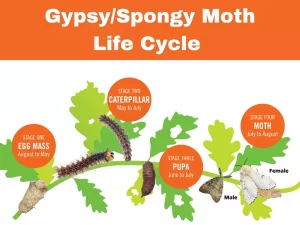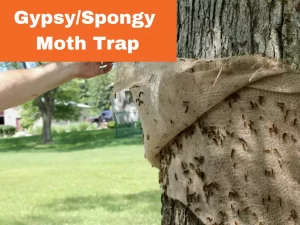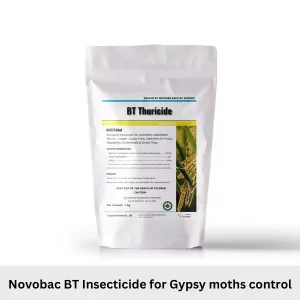Spongy moths (gypsy moths), can be highly damaging pests that cause significant damage to trees and forests. As a result, there can be severe ecological and economic implications associated with their infestations. The task of spongy moth control without causing harm to the ecosystem has become increasingly challenging.
In the late 19th century, individuals introduced spongy moths, a species of insects native to Europe and Asia, to North America. Since then, they have become a widespread and persistent pest in many parts of the continent.
Medium-sized insects with wingspans ranging from 1.5 to 2.5 inches can identify spongy moths. Male spongy insects are brownish-yellow, whereas their female counterparts are white and have black markings on their wings. Sponge caterpillars are easy to identify because they are hairy and have five pairs of blue and six pairs of red spots on their backs.
Spongy moths have a relatively simple life cycle, with four stages: egg, larva, pupa, and adult. Females lay their eggs on the bark of trees in late summer or early fall. The eggs survive the winter and hatch during the spring. The larvae emerge and begin feeding on foliage, growing rapidly over the course of several weeks. After reaching their full size, the larvae pupate and transform into adults. The adults reproduce by mating and laying eggs, initiating the cycle once again.

Understanding the life cycle of Gypsy moths is crucial for effective pest control
The most obvious sign of a spongy moth infestation is the presence of caterpillars on trees and foliage. They can often be seen in large numbers, crawling along branches and leaves. Other signs of infestation include skeletonized leaves, droppings, and webbing. The larvae of spongy moths can defoliate trees, which can result in reduced growth or dieback. This highlights the importance of actively using gypsy moth caterpillar killers to control their reproduction and minimize damage.
There are several strategies for protecting trees from spongy insect damage. One of the most effective is biological control, which involves using natural predators or pathogens to reduce their populations. Other strategies include physical barriers, such as sticky bands or netting, and chemical control, which involves using insecticides to control their larvae.
Physical barriers for spongy moth control involve creating a physical obstacle between the caterpillars and the trees they feed on. These barriers can take different forms, such as:

Protect your garden with a gypsy moth trap
While physical barriers can be effective in preventing spongy insect damage, they do have some disadvantages. For example:
Chemical control refers to the use of insecticides or pesticides to kill or control spongy caterpillar populations. People often use chemical control methods when the infestation of spongy moth is severe or widespread. Here are some examples of chemical control methods for spongy moth:
Disadvantages for chemical methods can control spongy moth populations, they come with several associated , including:
Biological control methods involve the use of natural enemies to manage pest populations. In the case of spongy moths, there are several organic control methods that have been successfully implemented.
BT Thuricide is an effective organic insecticide for gypsy moths control naturally, with active ingredient bacillus thuringiensis var kurstaki, producing a toxin that is lethal to spongy moth larvae which is specific to Lepidoptera larvae and has no effect on other insects or mammals.
BT Thuricide is organic gypsy moth killer to stop egg masses hatch. When the larvae ingest the Bt spores or the toxins produced by them, it damages their gut and leads to death. Bt has been used as an organic control agent for various insect pests, including spongy moth.
The use of Bt larvicide for spongy moth control is considered sustainably safe and has been extensively studied and documented in literature. Many studies have shown that BT-based products effectively control insect infestations and reduce damage to forests and trees. The effectiveness of Bt can vary depending on factors such as the timing and method of operation, as well as the density of the caterpillar.

Parasitoids are insects that lay their eggs inside the spongy moth larvae or eggs. The eggs hatch, and the larvae consume the host from the inside, eventually killing it. Natural enemies of spongy moths, such as parasitoids like Brachymeria inter-media and Chalcid wasps, can help regulate their groups-under.
fungi such as Beauveria bassiana and Metarhizium anisopliae are natural larvicides of spongy moths.
These fungi, acting as the gypsy moth killer, infect the larvae, causing them to stop feeding and eventually die. The fungi can be applied as a gypsy moth spray to the foliage of infested trees or as a bait to attract the larvae.
Predators such as birds, small mammals, and spiders are natural enemies of spongy moths. Encouraging the presence of these predators in the affected area can help to reduce spongy moth populations.
Unlike chemical pesticides, biological control pesticide are specific to their target pest and do not harm other useful insects or the ecosystem. They are also self-sufficient and can persist in the environment for long periods, providing ongoing control of the pest population.
Biological control agents are a promising alternative to chemical pesticides for controlling spongy moths. They can precisely target pests and have minimal impact on the ecosystem, making them an eco-friendly solution for managing spongy moth.
Furthermore, biological control agents are self-sufficient, which allows for ongoing control and is crucial in reducing the damage caused by pests.
1.Valaitis, Algimantas P. “Localization of Bacillus thuringiensis Cry1A toxin-binding molecules in gypsy moth larval gut sections using fluorescence microscopy.” Journal of invertebrate pathology 108.2 (2011): 69-75.
2. Bravo, Alejandra, et al. “Bacillus thuringiensis: a story of a successful bioinsecticide.”Insect biochemistry and molecular biology7 (2011): 423-431.
Cutworms in gardens are a major menace to all..
As a farmer,I inspect my fields daily to monitor..
It all started with a worried farmer named Mr...

Leave a Reply